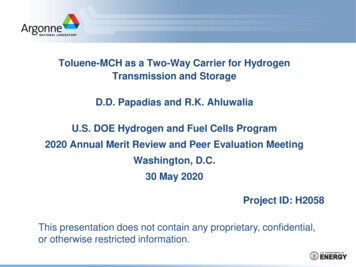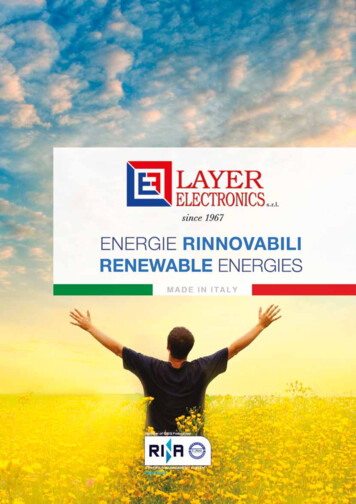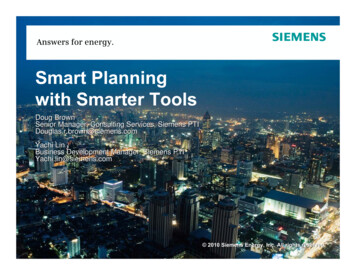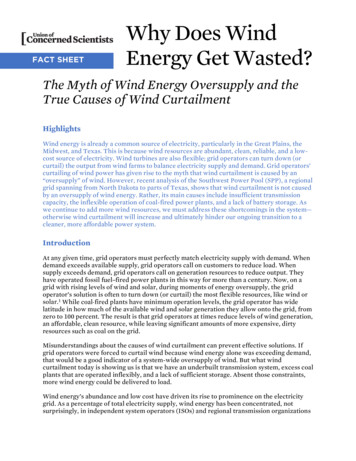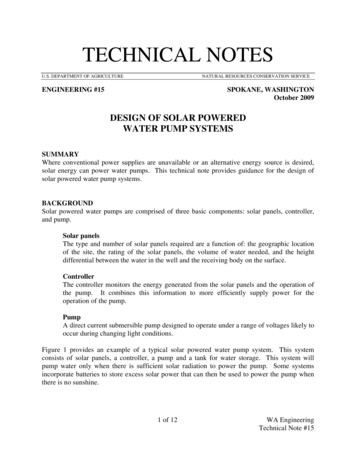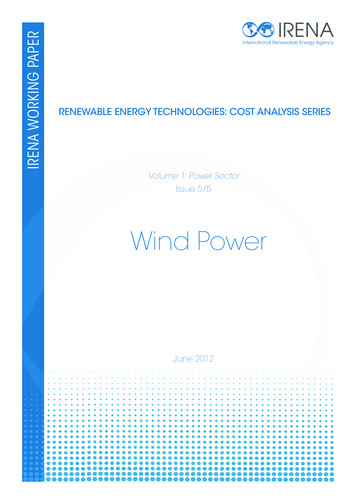
Transcription
Wind and SolarPower SystemsMukund R. Patel, Ph.D., P.E.U.S. Merchant Marine AcademyKings Point, New YorkFormerlyPrincipal Engineer, General Electric CompanyFellow Engineer, Westinghouse Reasearch CenterCRC PressBoca Raton London New York Washington, D.C.
Library of Congress Cataloging-in-Publication DataPatel, Mukind R., 1942.Wind and solar power systems / Mukund R. Patel.p. cm.Includes bibliographical references and index.ISBN 0-8493-1605-7 (alk. paper)1. Wind power plants. 2. Solar power plants. 3. Photovoltaic power systems. I. Title.TK1541.P38 1999621.31′2136—dc2198-47934CIPThis book contains information obtained from authentic and highly regarded sources. Reprinted materialis quoted with permission, and sources are indicated. A wide variety of references are listed. Reasonableefforts have been made to publish reliable data and information, but the author and the publisher cannotassume responsibility for the validity of all materials or for the consequences of their use.Neither this book nor any part may be reproduced or transmitted in any form or by any means, electronicor mechanical, including photocopying, microfilming, and recording, or by any information storage orretrieval system, without prior permission in writing from the publisher.The consent of CRC Press LLC does not extend to copying for general distribution, for promotion, forcreating new works, or for resale. Specific permission must be obtained in writing from CRC Press LLCfor such copying.Direct all inquiries to CRC Press LLC, 2000 N.W., Corporate Blvd., Boca Raton, Florida 33431.Trademark Notice: Product or corporate names may be trademarks or registered trademarks, and areused only for identification and explanation, without intent to infringe.Visit the CRC Press Web site at www.crcpress.com 1999 by CRC Press LLCNo claim to original U.S. Government worksInternational Standard Book Number 0-8493-1605-7Library of Congress Card Number 98-47934Printed in the United States of America2 3 4 5 6 7 8 9 0Printed on acid-free paper
dedicatedto my mother, Shakariba,who practiced ingenuity,andto my children, Ketan, Bina, and Vijal,who flattered me by being engineers.(Cover photo: Baix Ebre wind farm in Catalonia. With permission fromInstitut Catalia d’Energia, Spain.) 1999 by CRC Press LLC
PrefaceThe total electricity demand in 1997 in the United States of America wasthree trillion kWh, with the market value of 210 billion. The worldwidedemand was 12 trillion kWh in 1997, and is projected to reach 19 trillionkWh in 2015. This constitutes the worldwide average annual growth of2.6 percent. The growth rate in the developing countries is projected to beapproximately 5 percent, almost twice the world average.Most of the present demand in the world is met by fossil and nuclear powerplants. A small part is met by renewable energy technologies, such as thewind, solar, biomass, geothermal and the ocean. Among the renewable powersources, wind and solar have experienced a remarkably rapid growth in thepast 10 years. Both are pollution free sources of abundant power. Additionally,they generate power near the load centers, hence eliminate the need of running high voltage transmission lines through rural and urban landscapes.Since the early 1980s, the wind technology capital costs have declined by80 percent, operation and maintenance costs have dropped by 80 percentand availability factors of grid-connected plants have risen to 95 percent.These factors have jointly contributed to the decline of the wind electricitycost by 70 percent to 5 to 7 cents per kWh. The grid-connected wind plantcan generate electricity at cost under 5 cents per kWh. The goal of ongoingresearch programs funded by the U.S. Department of Energy and theNational Renewable Energy Laboratory is to bring the wind power costbelow 4 cents per kWh by the year 2000. This cost is highly competitive withthe energy cost of the conventional power technologies. For these reasons,wind power plants are now supplying economical clean power in manyparts of the world.In the U.S.A., several research partners of the NREL are negotiating withU.S. electrical utilities to install additional 4,200 MW of wind capacity withcapital investment of about 2 billion during the next several years. Thisamounts to the capital cost of 476 per kW, which is comparable with theconventional power plant costs. A recent study by the Electric PowerResearch Institute projected that by the year 2005, wind will produce thecheapest electricity available from any source. The EPRI estimates that thewind energy can grow from less than 1 percent in 1997 to as much as10 percent of this country’s electrical energy demand by 2020.On the other hand, the cost of solar photovoltaic electricity is still high inthe neighborhood of 15 to 25 cents per kWh. With the consumer cost ofelectrical utility power ranging from 10 to 15 cents per kWh nationwide,photovoltaics cannot economically compete directly with the utility poweras yet, except in remote markets where the utility power is not available and 1999 by CRC Press LLC
the transmission line costs would be prohibitive. Many developing countrieshave large areas falling in this category. With ongoing research in the photovoltaic (pv) technologies around the world, the pv energy cost is expectedto fall to 12 to 15 cents per kWh or less in the next several years as thelearning curves and the economy of scale come into play. The researchprograms funded by DOE/NREL have the goal of bringing down the pvenergy cost below 12 cents per kWh by 2000.After the restructuring of the U.S. electrical utilities, as mandated by theEnergy Policy Act (EPAct) of 1992, the industry leaders expect the powergeneration business, both conventional and renewable, to become more profitable in the long run. The reasoning is that the generation business will bestripped of regulated price and opened to competition among electricityproducers and resellers. The transmission and distribution business, on theother hand, would still be regulated. The American experience indicates thatthe free business generates more profits than the regulated business. Suchis the experience in the U.K. and Chile, where the electrical power industryhad been structured similar to the EPAct of 1992 in the U.S.A.As for the wind and pv electricity producers, they can now sell powerfreely to the end users through truly open access to the transmission lines.For this reason, they are likely to benefit as much as other producers ofelectricity. Another benefit in their favor is that the cost of the renewableenergy would be falling as the technology advances, whereas the cost of theelectricity from the conventional power plants would rise with inflation. Thedifference in their trends would make the wind and pv power even moreadvantageous in the future. 1999 by CRC Press LLC
About the AuthorMukund R. Patel, Ph.D, P.E., is an experienced research engineer with35 years of hands-on involvement in designing and developing state-of-theart electrical power equipment and systems. He has served as principalpower system engineer at the General Electric Company in Valley Forge,fellow engineer at the Westinghouse Research & Development Center inPittsburgh, senior staff engineer at Lockheed Martin Corporation in Princeton, development manager at Bharat Bijlee Limited, Bombay, and 3M distinguished visiting professor of electrical power technologies at theUniversity of Minnesota, Duluth. Presently he is a professor at the U.S.Merchant Marine Academy in Kings Point, New York.Dr. Patel obtained his Ph.D. degree in electric power engineering from theRensselaer Polytechnic Institute, Troy, New York; M.S. in engineering management from the University of Pittsburgh; M.E. in electrical machine designfrom Gujarat University and B.E.E. from Sardar University, India. He is afellow of the Institution of Mechanical Engineers (U.K.), senior member ofthe IEEE, registered professional engineer in Pennsylvania, and a memberof Eta Kappa Nu, Tau Beta Pi, Sigma Xi and Omega Rho.Dr. Patel has presented and published over 30 papers at national andinternational conferences, holds several patents, and has earned NASA recognition for exceptional contribution to the photovoltaic power systemdesign for UARS. He is active in consulting and teaching short courses toprofessional engineers in the electrical power industry. 1999 by CRC Press LLC
About the BookThe book was conceived when I was invited to teach a course in the emergingelectrical power technologies at the University of Minnesota in Duluth. Thelecture notes and presentation charts I prepared for the course formed thefirst draft of the book. The subsequent teaching of a couple of short coursesto professional engineers advanced the draft closer to the finished book. Thebook is designed and tested to serve as textbook for a semester course foruniversity seniors in electrical and mechanical engineering fields. The practicing engineers will get detailed treatment of this rapidly growing segmentof the power industry. The government policy makers would benefit byoverview of the material covered in the book.Chapters 1 through 3 cover the present status and the ongoing researchprograms in the renewable power around the world and in the U.S.A.Chapter 4 is a detailed coverage on the wind power fundamentals and theprobability distributions of the wind speed and the annual energy potentialof a site. It includes the wind speed and energy maps of several countries.Chapter 5 covers the wind power system operation and the control requirements. Since most wind plants use induction generators for converting theturbine power into electrical power, the theory of the induction machineperformance and operation is reviewed in Chapter 6 without going intodetails. The details are left for the classical books on the subject. The electricalgenerator speed control for capturing the maximum energy under windfluctuations over the year is presented in Chapter 7.The power-generating characteristics of the photovoltaic cell, the arraydesign, and the sun-tracking methods for the maximum power generationare discussed in Chapter 8. The basic features of the utility-scale solar thermal power plant using concentrating heliostats and molten salt steam turbineare presented in Chapter 9.The stand-alone renewable power plant invariably needs energy storagefor high load availability. Chapter 10 covers characteristics of various batteries, their design methods using the energy balance analysis, factors influencing their operation, and the battery management methods. The energydensity and the life and operating cost per kWh delivered are presented forvarious batteries, such as lead-acid, nickel-cadmium, nickel-metal-hydrideand lithium-ion. The energy storage by the flywheel, compressed air and thesuperconducting coil, and their advantages over the batteries are reviewed.The basic theory and operation of the power electronic converters and inverters used in the wind and solar power systems are presented in Chapter 11,leaving details for excellent books available on the subject. 1999 by CRC Press LLC
The more than two billion people in the world not yet connected to theutility grid are the largest potential market of stand-alone power systems.Chapter 12 presents the design and operating methods of such power systems using wind and photovoltaic systems in hybrid with diesel generators.The newly developed fuel cell with potential of replacing diesel engine inurban areas is discussed. The grid-connected renewable power systems arecovered in Chapter 13, with voltage and frequency control methods neededfor synchronizing the generator with the grid. The theory and the operatingcharacteristics of the interconnecting transmission line, the voltage regulation, the maximum power transfer capability, and the static and dynamicstability are covered.Chapter 14 is about the overall electrical system design. The method ofdesigning the system components to operate at their maximum possibleefficiency is developed. The static and dynamic bus performance, the harmonics, and the increasingly important quality of power issues applicableto the renewable power systems are presented.Chapter 15 discusses the total plant economy and the costing of energydelivered to the paying customers. It also shows the importance of a sensitivity analysis to raise confidence level of the investors. The profitabilitycharts are presented for preliminary screening of potential sites. Finally,Chapter 16 discusses the past and present trends and the future of the greenpower. It presents the declining price model based on the learning curve,and the Fisher-Pry substitution model for predicting the market growth ofthe wind and pv power based on historical data on similar technologies. Theeffect of the utility restructuring, mandated by the EPAct of 1992, and itsexpected benefits on the renewable power producers are discussed.At the end, the book gives numerous references for further reading, andname and addresses of government agencies, universities, and manufacturers active in the renewable power around the world. 1999 by CRC Press LLC
AcknowledgmentThe book of this nature on emerging technologies, such as the wind andphotovoltaic power systems, cannot possibly be written without the helpfrom many sources. I have been extremely fortunate to receive full supportfrom many organizations and individuals in the field. They not only encouraged me to write the book on this timely subject, but also provided valuablesuggestions and comments during the development of the book.Dr. Nazmi Shehadeh, head of the Electrical and Computer EngineeringDepartment at the University of Minnesota, Duluth, gave me the opportunityto develop and teach this subject to his students who were enthusiastic aboutlearning new technologies. Dr. Elliott Bayly, president of the World PowerTechnologies in Duluth, shared with me and my students his long experiencein the field. He helped me develop the course outline, which later becamethe book outline. Dr. Jean Posbic of Solarex Corporation in Frederick, Maryland and Mr. Carl-Erik Olsen of Nordtank Energy Group/NEG Micon,Denmark, kindly reviewed the draft and provided valuable suggestions forimprovement. Mr. Bernard Chabot of ADEME, Valbonne, France, providedthe profitability charts for screening the wind and photovoltaic power sites.Mr. Ian Baring-Gould of the National Renewable Energy Laboratory,Golden, Colorado, has been a source of useful information and the hybridpower plant simulation model.Several institutions worldwide provided current data and reports on theserather rapidly developing technologies. They are the American Wind EnergyAssociation, the American Solar Energy Society, the European WindEnergy Association, the Risø National Laboratory, Denmark, the TataEnergy Research Institute, India, and many corporations engaged in thewind and solar power technologies. Many individuals at these organizationsgladly provided help I requested.I gratefully acknowledge the generous support from all of you.Mukund PatelYardley, Pennsylvania 1999 by CRC Press LLC
Contents1.Introduction1.1Industry Overview1.2Incentives for Renewables1.3Utility nces2.Wind Power2.1Wind in the World2.2The U.S.A.2.3Europe2.4India2.5Mexico2.6Ongoing Research and DevelopmentReferences3.Photovoltaic Power3.1Present Status3.2Building Integrated pv Systems3.3pv Cell Technologies3.3.1Single-Crystalline Silicon3.3.2Polycrystalline and Semicrystalline3.3.3Thin Films3.3.4Amorphous Silicon3.3.5Spheral3.3.6Concentrated Cells3.4pv Energy MapsReferences4.Wind4.14.24.34.44.54.6Speed and Energy DistributionsSpeed and Power RelationsPower Extracted from the WindRotor Swept AreaAir DensityGlobal Wind PatternsWind Speed Distribution4.6.1Weibull Probability Distribution4.6.2Mode and Mean Speeds 1999 by CRC Press LLC
4.6.3Root Mean Cube Speed4.6.4Mode, Mean, and rmc Speeds Compared4.6.5Energy Distribution4.6.6Digital Data Loggers4.6.7Effect of Height4.6.8Importance of Reliable Data4.7Wind Speed Prediction4.8Wind Resource Maps4.8.1The U.S.A.4.8.2Minnesota4.8.3The United .Wind Power System5.1System Components5.1.1Tower5.1.2Turbine Blades5.1.3Yaw Control5.1.4Speed Control5.2Turbine Rating5.3Electrical Load Matching5.4Variable-Speed Operation5.5System Design Features5.5.1Number of Blades5.5.2Rotor Upwind or Downwind5.5.3Horizontal Axis Versus Vertical Axis5.5.4Spacing of the Towers5.6Maximum Power Operation5.6.1Constant Tip-Speed Ratio Scheme5.6.2Peak Power Tracking Scheme5.7System Control Requirements5.7.1Speed Control5.7.2Rate Control5.8Environmental Aspects5.8.1Audible Noise5.8.2Electromagnetic Interference (EMI)References6.Electrical Generator6.1Electromechanical Energy Conversion6.1.1DC Machine6.1.2Synchronous Machine6.1.3Induction Machine 1999 by CRC Press LLC
6.2Induction Generator6.2.1Construction6.2.2Working Principle6.2.3Rotor Speed and Slip6.2.4Equivalent Circuit for Performance Calculations6.2.5Efficiency and Cooling6.2.6Self-Excitation Capacitance6.2.7Torque-Speed Characteristic6.2.8TransientsReferences7.Generator Drives7.1Speed Control Regions7.2Generator Drives7.2.1One Fixed-Speed Drive7.2.2Two Fixed-Speeds Drive7.2.3Variable-Speed Using Gear Drive7.2.4Variable-Speed Using Power Electronics7.2.5Scherbius Variable-Speed Drive7.2.6Variable-Speed Direct Drive7.3Drive Selection7.4Cut-Out Speed r Thermal System9.1Energy Collection9.1.1Parabolic Trough9.1.2Central Receiver9.1.3Parabolic DishPhotovoltaic Power SystemThe pv CellModule and ArrayEquivalent Electrical CircuitOpen Circuit Voltage and Short Circuit Currenti-v and p-v CurvesArray Design8.6.1Sun Intensity8.6.2Sun Angle8.6.3Shadow Effect8.6.4Temperature Effect8.6.5Effect of Climate8.6.6Electrical Load Matching8.6.7Sun Tracking8.7Peak Power Point Operation8.8pv System ComponentsReferences 1999 by CRC Press LLC
9.29.3Solar II Power PlantSynchronous Generator9.3.1Equivalent Electrical Circuit9.3.2Excitation Methods9.3.3Electrical Power Output9.3.4Transient Stability Limit9.4Commercial Power PlantsReferences10. Energy Storage10.1 Battery10.2 Types of Batteries10.2.1 Lead-Acid10.2.2 Nickel Cadmium10.2.3 Nickel-Metal Hydride10.2.4 Lithium-Ion10.2.5 Lithium-Polymer10.2.6 Zinc-Air10.3 Equivalent Electrical Circuit10.4 Performance Characteristics10.4.1 Charge/Discharge Voltages10.4.2 Charge/Discharge Ratio10.4.3 Energy Efficiency10.4.4 Internal Resistance10.4.5 Charge Efficiency10.4.6 Self-Discharge and Trickle Charge10.4.7 Memory Effect10.4.8 Effects of Temperature10.4.9 Internal Loss and Temperature Rise10.4.10 Random Failure10.4.11 Wear-Out Failure10.4.12 Various Batteries Compared10.5 More on Lead-Acid Battery10.6 Battery Design10.7 Battery Charging10.8 Charge Regulators10.8.1 Multiple Charge Rates10.8.2 Single Charge Rate10.8.3 Unregulated Charging10.9 Battery Management10.9.1 Monitoring and Controls10.9.2 Safety10.10 Flywheel10.10.1 Energy Relations10.10.2 Flywheel System Components10.10.3 Flywheel Benefits Over Battery 1999 by CRC Press LLC
10.11 Compressed Air10.12 Superconducting CoilReferences11. Power Electronics11.1 Basic Switching Devices11.2 AC to DC Rectifier11.3 DC to AC Inverter11.4 Grid Interface Controls11.4.1 Voltage Control11.4.2 Frequency Control11.5 Battery Charge/Discharge Converters11.5.1 Battery Charge Converter11.5.2 Battery Discharge Converter11.6 Power ShuntsReferences12. Stand-Alone System12.1 pv Stand-Alone12.2 Electric Vehicle12.3 Wind Stand-Alone12.4 Hybrid System12.4.1 Hybrid with Diesel12.4.2 Hybrid with Fuel Cell12.4.3 Mode Controller12.4.4 Load Sharing12.5 System Sizing12.5.1 Power and Energy Estimates12.5.2 Battery Sizing12.5.3 pv Array Sizing12.6 Wind Farm SizingReferences13. Grid-Connected System13.1 Interface Requirements13.2 Synchronizing with Grid13.2.1 Inrush Current13.2.2 Synchronous Operation13.2.3 Load Transient13.2.4 Safety13.3 Operating Limit13.3.1 Voltage Regulation13.3.2 Stability Limit13.4 Energy Storage and Load Scheduling13.5 Utility Resource Planning ToolReferences 1999 by CRC Press LLC
14. Electrical Performance14.1 Voltage Current and Power Relations14.2 Component Design for Maximum Efficiency14.3 Electrical System Model14.4 Static Bus Impedance and Voltage Regulation14.5 Dynamic Bus Impedance and Ripple14.6 Harmonics14.7 Quality of Power14.7.1 Harmonic Distortion14.7.2 Voltage Transients and Sags14.7.3 Voltage Flickers14.8 Renewable Capacity Limit14.8.1 Systems Stiffness14.8.2 Interfacing Standards14.9 Lightning Protection14.10 National Electrical Code on Renewable Power SystemsReferences15. Plant15.115.215.315.415.5EconomyEnergy Delivery FactorInitial Capital CostAvailability and MaintenanceEnergy Cost EstimatesSensitivity Analysis15.5.1 Effect of Wind Speed Variations15.5.2 Effect of Tower Height15.6 Profitability Index15.6.1 Wind Farm Screening Chart15.6.2 pv Park Screening Chart15.6.3 Stand-Alone pv Versus Grid Line15.7 Hybrid EconomicsReferences16. The Future16.1 World Electricity Demand to 201516.2 Wind Future16.3 pv Future16.4 Declining Production Costs16.5 Market Penetration16.6 Effect of Utility Restructuring16.6.1 Energy Policy Act of 199216.6.2 Impact on Renewable Power ProducersReferencesFurther ReadingAppendix 1 1999 by CRC Press LLC
Appendix 2AcronymsConversion of Units 1999 by CRC Press LLC
1Introduction1.1Industry OverviewThe total annual primary energy consumption in 1997 was 390 quadrillion(1015) BTUs worldwide1 and over 90 quadrillion BTUs in the United Statesof America, distributed in segments shown in Figure 1-1. About 40 percentof the total primary energy is used in generating electricity. Nearly 70 percentof the energy used in our homes and offices is in the form of electricity. Tomeet this demand, 700 GW of electrical generating capacity is now installedin the U.S.A. For most of this century, the U.S. electric demand has increasedwith the gross national product (GNP). At that rate, the U.S. will need toinstall additional 200 GW capacity by the year 2010.The new capacity installation decisions today are becoming complicatedin many parts of the world because of difficulty in finding sites for newgeneration and transmission facilities of any kind. In the U.S.A., no nuclearpower plants have been ordered since 19782 (Figure 1-2). Given the potentialfor cost overruns, safety related design changes during the construction, andlocal opposition to new plants, most utility executives suggest that none willbe ordered in the foreseeable future. Assuming that no new nuclear plantsare built, and that the existing plants are not relicensed at the expiration oftheir 40-year terms, the nuclear power output is expected to decline sharplyafter 2010. This decline must be replaced by other means. With gas pricesexpected to rise in the long run, utilities are projected to turn increasinglyto coal for base load-power generation. The U.S.A. has enormous reservesof coal, equivalent to more than 250 years of use at current level. However,that will need clean coal burning technologies that are fully acceptable tothe public.An alternative to the nuclear and fossil fuel power is renewable energytechnologies (hydro, wind, solar, biomass, geothermal, and ocean). Largescale hydroelectric projects have become increasingly difficult to carrythrough in recent years because of competing use of land and water. Relicensing requirements of existing hydro plants may even lead to removal ofsome dams to protect or restore wildlife habitats. Among the other renewable 1999 by CRC Press LLC
FIGURE 1-1Primary energy consumption in the U.S.A. in three major sectors, total 90 quadrillion BTUs in1997. (From U.S. Department of Energy, Office of the Integrated Analysis and Forecasting,Report No. DE-97005344, April 1997.)FIGURE 1-2The stagnant nuclear power capacity worldwide. (From Felix, F., State of the nuclear economy,IEEE Spectrum, November 1997. 1997 IEEE. With permission.)power sources, wind and solar have recently experienced a rapid growtharound the world. Having wide geographical spread, they can be generatednear the load centers, thus simultaneously eliminating the need of highvoltage transmission lines running through rural and urban landscapes.The present status and benefits of the renewable power sources are compared with the conventional ones in Tables 1-1 and 1-2, respectively.The renewables compare well with the conventionals in economy. Manyenergy scientists and economists believe that the renewables would get muchmore federal and state incentives if their social benefits were given full credit. 1999 by CRC Press LLC
TABLE 1-1Status of Conventional and Renewable Power SourcesConventionalRenewablesCoal, nuclear, oil, and natural gasFully matured technologiesNumerous tax and investment subsidiesembedded in national economiesAccepted in society under the ‘grandfatherclause’ as necessary evilWind, solar, biomass geothermal, and oceanRapidly developing technologiesSome tax credits and grants available from somefederal and/or state governmentsBeing accepted on its own merit, even withlimited valuation of their environmental andother social benefitsTABLE 1-2Benefits of Using Renewable ElectricityNontraditional BenefitsPer Million kWh consumedTraditional BenefitsMonetary value of kWh consumedU.S. average 12 cents/kWhU.K. average 7.5 pence/kWhReduction in emission750–1000 tons of CO27.5–10 tons of SO23–5 tons of NOx50,000 kWh reduction in energy loss in power lines andequipmentLife extension of utility power distribution equipmentLower capital cost as lower capacity equipment can beused (such as transformer capacity reduction of 50 kWper MW installed)For example, the value of not generating one ton of CO2, SO2, and NOx, andthe value of not building long high voltage transmission lines through ruraland urban areas are not adequately reflected in the present evaluation of therenewables.1.2Incentives for RenewablesA great deal of renewable energy development in the U.S.A. occurred in the1980s, and the prime stimulus for it was the passage in 1978 of the PublicUtility Regulatory Policies Act (PURPA). It created a class of nonutility powergenerators known as the “qualified facilities (QFs)”. The QFs were definedto be small power generators utilizing renewable energy sources and/orcogeneration systems utilizing waste energy. For the first time, PURPArequired electric utilities to interconnect with QFs and to purchase QFs’power generation at “avoided cost”, which the utility would have incurredby generating that power by itself. PURPA also exempted QFs from certain 1999 by CRC Press LLC
federal and state utility regulations. Furthermore, significant federal investment tax credit, research and development tax credit, and energy tax credit,liberally available up to the mid 1980s, created a wind rush in California,the state that also gave liberal state tax incentives. As of now, the financialincentives in the U.S.A. are reduced, but are still available under the EnergyPolicy Act of 1992, such as the energy tax credit of 1.5 cents per kWh. Thepotential impact of the 1992 act on renewable power producers is reviewedin Chapter 16.Globally, many countries offer incentives and guaranteed price for therenewable power. Under such incentives, the growth rate of the wind powerin Germany and India has been phenomenal.1.3Utility PerspectiveUntil the late 1980s, the interest in the renewables was confined primarilyamong private investors. However, as the considerations of fuel diversity,environmental concerns and market uncertainties are becoming importantfactors into today’s electric utility resource planning, renewable energy technologies are beginning to find their place in the utility resource portfolio.Wind and solar power, in particular, have the following advantages to theelectric utilities: Both are highly modular in that their capacity can be increasedincrementally to match with gradual load growth. Their construction lead time is significantly shorter than those of theconventional plants, thus reducing the financial and regulatory risks. They bring diverse fuel sources that are free of cost and free ofpollution.Because of these benefits, many utilities and regulatory bodies are increasingly interested in acquiring hands on experience with renewable energytechnologies in order to plan effectively for the future. The above benefitsare discussed below in further details.1.3.1ModularityThe electricity demand in the U.S.A. grew at 6 to 7 percent until the late1970s, tapering to just 2 percent in the 1990s as shown in Figure 1-3.The 7 percent growth rate of the 1970s meant doubling the electrical energydemand and the installed capacity every 10 years. The decline in the growthrate since then has come partly from the improved efficiency in electricityutilization through programs funded by the U.S. Department of Energy. Thesmall growth rate of the 1990s is expected to continue well into the next century. 1999 by CRC Press LLC
FIGURE 1-3Growth of electricity demand in the U.S.A. (Source: U.S. Department of Energy and ElectricPower Research Institute)The economic size of the conventional power plant has been 500 MW to1,000 MW capacity. These sizes could be justified in the past, as the entirepower plant of that size, once built, would be fully loaded in just a few years.At a 2 percent growth rate, however, it could take decades before a 500 MWplant could be fully loaded after it is commissioned in service. Utilities areunwilling to take such long-term risks in making investment decisions. Thishas created a strong need of modularity in today’s power generation industry.Both the wind and the solar photovoltaic power are highly modular. Theyallow installations in stages as needed without losing the economy of sizein the first installation
The power-generating characteristics of the photovoltaic cell, the array design, and the sun-tracking methods for the maximum power generation are discussed in Chapter 8. The basic features of the utility-scale solar ther-mal power plant using concentrating heliostats

